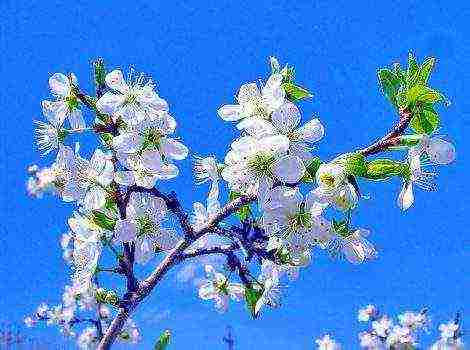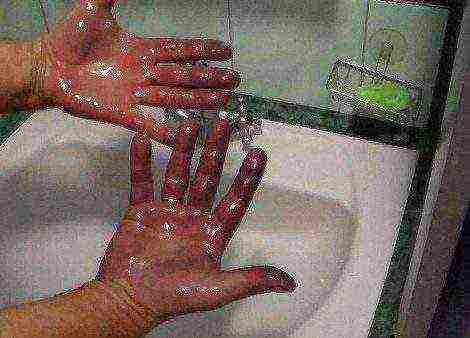Content
Rowan Pomegranate is a useful berry, with the properties of which almost all gardeners and summer residents are familiar. She has beautiful ornamental plants, and her berries have a high level of nutrients... Therefore, it is imperative to plant this berry variety on your site so that it pleases not only with a beautiful view, but also with its high useful yields, and you can find a description of this berry below.
The first who began to engage in the cultivation of rowan varieties is I.V. Michurin. Back in 1925, he pollinated flowers of Siberian hawthorn or blood-red hawthorn with rowan pollen. As a result, he received quite high-quality planting material. The hybrid was named - Crategosorbus Michurin... He became one of the best among hybrid plants, already in the fifth year he received high yields. Fruits are large with a dark red pomegranate color... Therefore, this hybrid was named Pomegranate.
Description of the variety of mountain ash Pomegranate
Tree characteristics
Rowan pomegranate has a fairly tall tree with spreading branches. The height of the tree can be up to 4 meters. The standard of living is usually between 20 and 25 years old.

The main characteristics of the tree:
- Crown the tree is wide, dense;
- Escapes they easily take root, they can easily withstand frost and extreme heat;
- Leaves have a decorative appearance. The size of the leaves is large, the color is dark green. They have a regular, odd-pinnate structure. The leaves include 9-11 oblong leaflets;
- Leaves length size is approximately 12 cm, width size - 6 cm;
- Trees have lobe root system, the root structure is well developed.
Bloom
During the flowering period, white flowers appear on the tree. The size of the flowers is small. They are collected in bunches of corymbose-type inflorescences of 100 pieces.
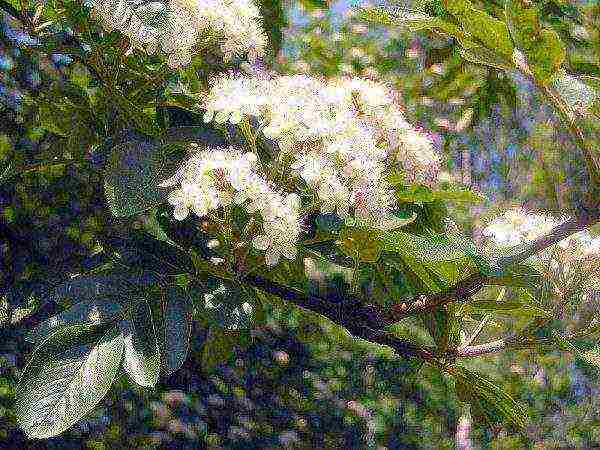
Ripe fruits in young trees are located in large numbers on the base of fruit twigs... In adult plants, fruits grow on ringlets, the life span of which is no more than 5 years.
Description of fruits
The main qualities of the fruit:
- Ripe rowan fruits have the shape of a ball with a faceted structure;
- Coloring berries with a burgundy-red tintwhich has a bluish bloom;
- Inside the berries there is yellow pulp with a juicy texture;
- Berry has sour taste with a sweet aftertaste, additionally there may be a slight astringency;
- Weight of one mature fruit ranges from 1.2 to 1.6 grams.
Yield
The yield of the Pomegranate mountain ash is quite high. Usually almost 18-20 kilograms are harvested from one tree good berries with large sizes. The harvest depends on the observance of proper care of the plant - watering, weeding, fertilization.
Harvesting
Rowan variety Pomegranate refers to early-growing varieties. Fruiting begins as early as 4 years old after planting seedlings. Trees are highly productive.
When storing berries in a cool dry room, the longest maturation period is almost 5 months. Fresh berries can be dried, frozen... In addition, various preparations for the winter can be prepared from them.
Pollination
Rowan varieties Pomegranate refers to self-fertile varieties. But still, many gardeners recommend using the cross-pollination method to improve yield levels... Usually, for the cross-pollination method, rowan varieties such as Dessertnaya, Vefed, Sorbinka are used.
Advantages and disadvantages
Before planting a mountain ash of the Pomegranate variety, it is worth examining its positive qualities. In addition to the valuable qualities, this variety also has negative sides., which are also worth paying attention to.
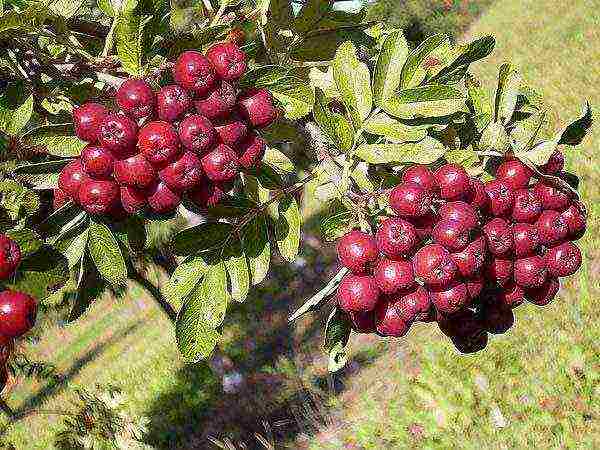
Positive traits:
- Variety able to withstand severe frosts, therefore, it can be planted in the northern regions of Russia;
- High yield, up to 2 large buckets of ripe fruits can be removed from one tree per season;
- Rowan Pomegranate belongs to self-fertile varieties, therefore, when planting, you will not need to additionally plant pollinators. But still, many gardeners recommend planting pollinators for cross-pollination to increase yields;
- Ripe fruits have big sizes;
- Good taste qualities without bitterness;
- Berries can be stored long time.
The negative qualities include the following disadvantages:
- Short service juice. The Pomegranate rowan tree lives on average from 20 to 25 years;
- Average resistance to the effects of harmful insects and diseases.
Landing features
For planting this variety, you can use drained sod and sod-slightly podzolic loamy soil. On this soil, trees grow best and are quickly accepted.
The most suitable season for planting mountain ash is the autumn period.... It is also allowed to plant in the spring, but the main thing is to do it before bud break. In addition, for planting, you should choose a sunny place with good sunlight. In shaded areas, rowan will produce low yields with poor quality.

How to plant:
- First thing a hole is being dug for planting;
- The size of the diameter of the future hole should be 1 meter, the depth level should be approximately half a meter;
- The bottom layer of soil must be mixed with 20 kilograms of humus, 400 grams of superphosphate, 200-300 grams of potassium sulfate;
- Deepen the neck root type in the ground is necessary for 4-5 cm;
- After that the seedling needs to be watered plenty of water, at least 2 buckets;
- Mulching is carried out a layer of at least 8-10 cm;
- You can use compost for looseningmixed with wood ash.
Care
Watering and loosening
Rowan Pomegranate loves to grow on moist soil, but it does not tolerate strong stagnation of water. In the absence of precipitation, the mountain ash should be watered three times. Watering is carried out according to the scheme:
- First watering performed at the beginning of the growing season;
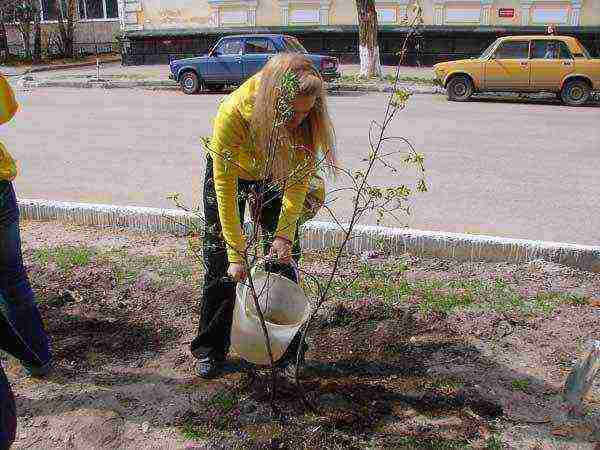
- Next watering performed approximately 17-21 days before harvest;
- Last watering produced approximately 21-28 days after harvest.
Be sure to loosen the soil well after each watering, this will allow you to keep the right amount of water in the soil. Besides loosening the soil is recommended during early spring and autumn, in preparation for winter. It is recommended to dig up the ground no deeper than 15 cm so as not to harm the roots.
Pruning features
It is imperative to prune trees during the growth process. Sanitary and formative pruning is carried out.
Pruning features:
- In spring, trees begin to grow earlier, therefore circumcision should be done before the kidneys swell;
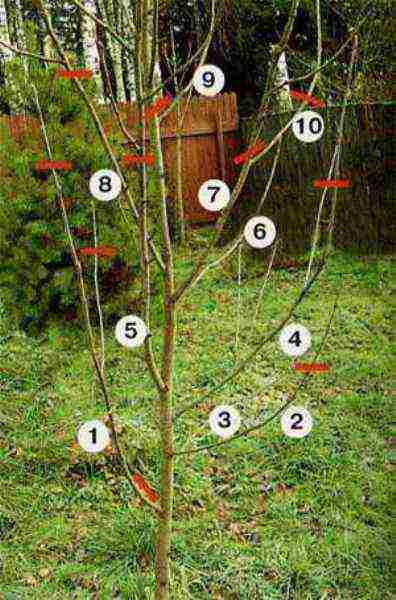
- In young plants shortening by 1 bud is made, shoots are removed, due to which an acute angle is formed;
- For mature trees circumcision is done as needed. Usually it is done to form the shape of the crown, as well as to thin it out;
- All the lower branches shoots near the roots are cut;
- Other branches are shortened by 1/3.
Fertilization features
If during planting fertilizer mixtures were introduced into the planting hole, then during the first three years the pomegranate mountain ash should be fertilized. In the springtime during the digging of the earth, it is necessary to make 25 grams of ammonium nitrate or urea. From the fourth year of life except in spring, feeding is done in the fall. In the autumn period during digging, 50 grams of superphosphate and 30 grams of potassium are introduced into the soil.
Distinctive features
Rowan variety Pomegranate has undersized trees. Trees have an extraordinary beautiful appearance that brightens up the entire garden area... Trees will delight you with their beauty even in winter. In addition, the Pomegranate mountain ash has large berries. Ripe berries acquire an unusual dark red shade with a bluish tint. Another distinctive feature of the plant is its short life span.
Diseases and pests
Rowan Pomegranate has low resistance to the effects of diseases and pests. In order to protect the tree and the crop from pests and diseases, it is necessary to carry out timely prevention... If the plant is already affected, then in this case, treatment is carried out with the help of special preparations.
| Name of defeat | How striking | How to fix |
|---|---|---|
| Rowan aphid | It damages and deforms the structure of the leaves | Treatment is carried out with a 0.2% solution of karbofos (75 grams of water is required for a bucket of water) in the summer before the ovaries, for prevention, treatments are done with a 2% solution of nitrafen (300 grams per 10 liters) in the spring before the appearance of the kidneys, After the appearance of the kidneys, treatments are carried out 0 , 1% solution of Rogora-S - 1 liter is required for 1 square meter |
| Rowan gall mite | Damages leaf structure | For treatment, a 1% solution of colloidal sulfur is used before flowering. In the autumn period, trunks are dug up, the old rotten crop is removed. |
| Rowan moth | There is damage to the structure of the pulp by caterpillars | 2 weeks after the end of flowering, it is treated with a 0.2% chlorophos solution, 20 grams of the drug must be added to 10 liters of water. |
| Moniliosis | This disease completely damages the structure of trees, it causes the formation of dark growths. | In spring, before buds appear, trees are treated with nitrafen (300 g / 10 l of water) or copper sulfate (100 g / 10 l of water). The affected areas of trees should be cut and burned. |
| Powdery mildew | This disease causes the formation of a white coating on the surface of the leaves, which causes them to die off completely. | Before flowering, all affected leaves must be torn off and they must be completely burned. Treatments are carried out with a solution of colloidal sulfur (30 g / 10 l of water). Every 4 days, until the lesion is completely removed, treatments are made from a soap solution - 10 liters of water, 3 tablespoons of baking soda, 1 large spoonful of liquid soap. |
Rowan Pomegranate is a high-yielding variety that is quite unpretentious in cultivation. The trees of this mountain ash can grow in almost any climate, they can withstand severe frosts and at the same time retain all their properties.... Disembarkation and further care does not require much work.The main thing is to water, fertilize and carry out treatments against parasites and diseases during the time.
